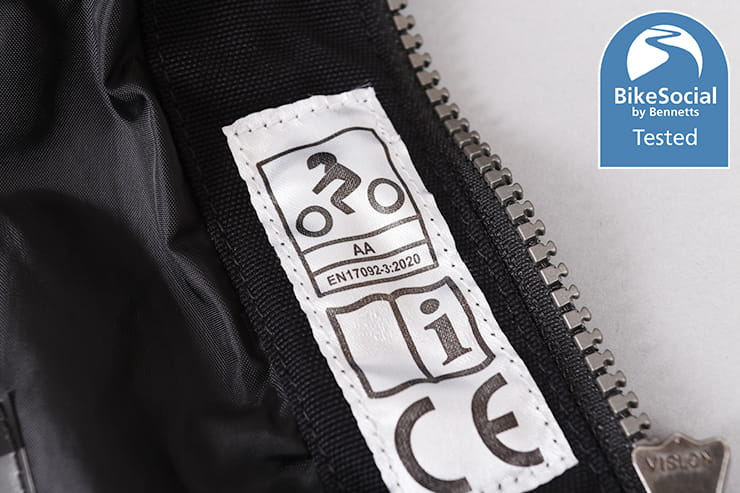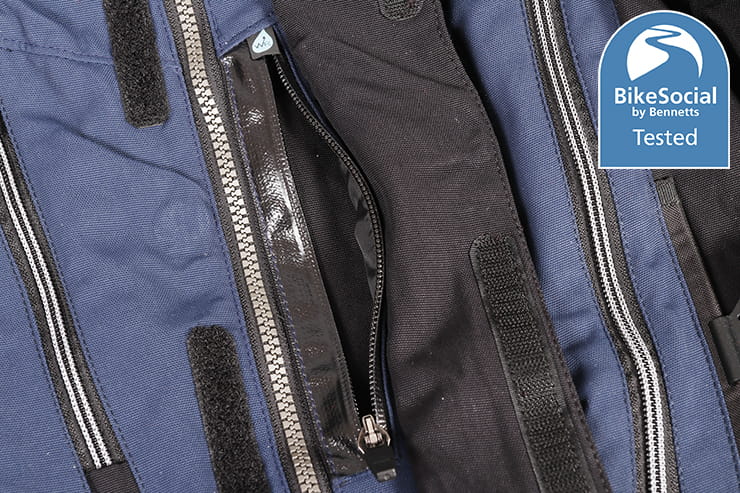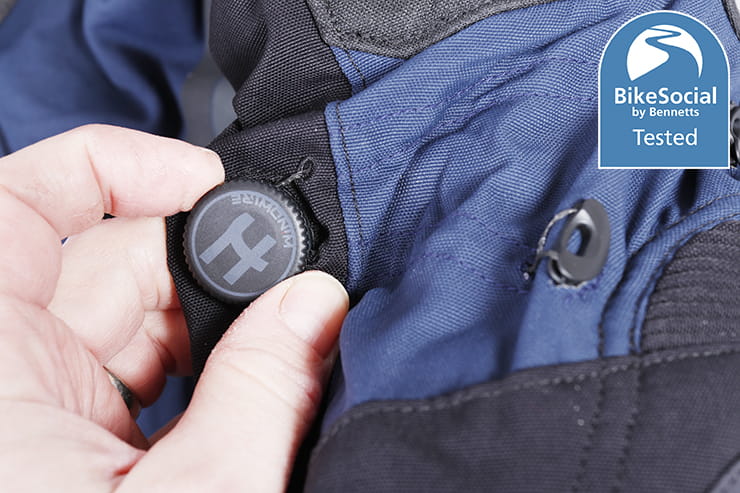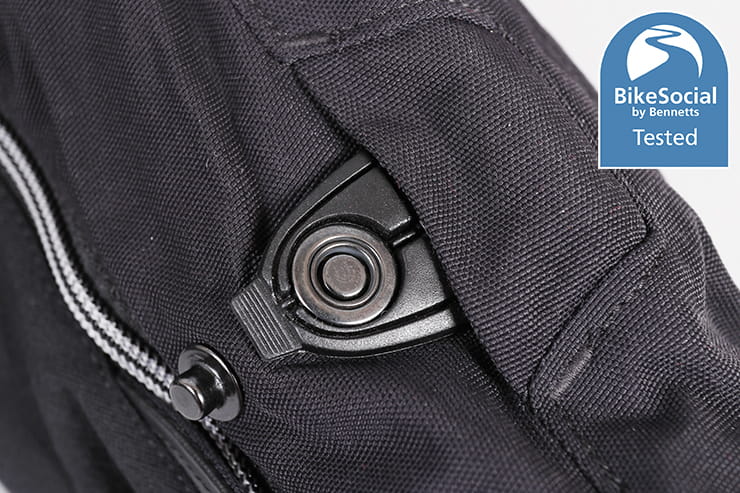Date reviewed: February 2022 | Tested by: BikeSocial community member Ben Cordy | RRP: £639 | halvarssonsmc.com
The Halvarssons Mora on review here claims to be an all-season adventure touring jacket pitched at the more premium end of the textile market. Packed with Halvarssons’ in-house technologies and quality materials, the Mora is a compelling piece of kit presenting a real alternative to the growing trend of laminated waterproof jackets.
After nearly 1,000 miles of mixed riding on board my trusty Honda CB500X – commuting, travelling and exploring – here’s how the Mora stacked up to a very changeable British winter…
For and against
- Highly adjustable fit
- Fantastic breathability and venting
- Premium materials and finish
- Ineffective waterproof coating on the outer shell
- Elbow armour can be uncomfortable when standing
- Waterproof liner doesn’t cover the full sleeve length
Construction and Fit
From the outset the fit and finish of the Mora is very impressive; well-utilised premium materials and clever little touches make this jacket feel like it’s worth every penny of its somewhat premium price tag. The addition of nubuck to the shoulders and elbows, the accordion stretch panels, and the use throughout of magnets and premium fastenings shows an attention to detail that makes the Mora a solid piece of kit.
I’m usually a small or EU48 in jackets with the EU48 Mora being true to size. The only small gripe being that the sleeves were a little on the long side for me. With my arms fully straightened the Halvarssons sleeves extend roughly 1cm over my palm, leading to a bit of bunching up once my gloves are on and tightened. Of course, fit is extremely subjective, so trying one on is the only way you’ll know how it works for you.
The adjustability, which I’ll explore in more detail below, makes it easy to adapt the jacket to suit. There’s plenty of give to allow for additional layers beneath the outer shell and removable liner, easily accommodating my heated jacket and all while not feeling overly baggy or bulky with thinner layers.
One of the Mora’s best qualities is its comfort in use. While not an overly light jacket it disappears once on and proves distraction-free doing its job of keeping you warm, dry(ish) and safe. The collar deserves specific mention as one of the most comfortable jacket collars I’ve used. I can’t quite work out what they’ve done differently but the freedom of movement at the neck is noticeably better than most other jackets, which is crucial to keeping focus on the road and enabling swift observations on the go.
Like most jackets in the adventure touring segment, the Mora is relatively long bodied, keeping you well protected from the elements. The addition of a very wel-made connector panel for trousers, plus a storm collar, are really nice touches that add to the overall package. The matching Halvarssons Malung trousers weren’t available at the point of testing, however both the outer jacket and inner liner have zips to enable connection to the trousers, giving a well-sealed two-piece setup.
Protection and certification
The Mora is certified to CE Level AA (EN17092) with CE Level 2 armour (the highest impact protection) supplied at the elbows and shoulders. Additionally there’s a pocket for a back protector although one isn’t supplied. The Halvarssons Huntly Level 2 back protector comes in at £64, but I’ve utilised my preferred D3O protector instead. It’s worth noting that the pocket for the back protector is very large and you may need to make sure any protector you choose is sized such that it remains in the correct position once fitted.
Shot here with direct flash, the reflective panels on the shoulders, front and back add extra safety at night
At key impact zones Halvarssons has utilised its own HI-ART reinforcement, which increases the jacket’s abrasion resistance and maintains the strength of the material in a crash. On top of the HI-ART material are thick panels of nubuck that not only add to the premium look of the jacket, but also serve to further increase its durability and abrasion resistance in the event of an accident.
The supplied armour is relatively large, quite firm and purposefully shaped. This is of course no problem when in the seated riding position, however once stood on the pegs I did find the curve of the elbow armour quite uncomfortable with straightened arms. While not desperately painful I would be hesitant about all-day trail riding with the supplied armour. A softer armour might resolve the situation, but again it’s something you can feel for yourself when trying one on.
For everything you need to know about the safety labels in your motorcycle kit, click here.
Pockets
Like most jackets in this segment the Mora isn’t short of pockets, with seven spread across the outer shell. Like the rest of the jacket these are finished with premium zips, magnet closures and are nicely trimmed in line with the general quality and finish.
To the front are two large waist pockets with fold-over storm flaps sealed by a combination of magnets and Velcro; hugely beneficial if like me you constantly forget to close your pockets before riding. These are joined by two slim chest pockets roughly the size of the average smart phone, which can also serve as additional chest vents when required.
Inside there’s a further two pockets, with one to each side of the central storm flap and one benefiting from a water tight zip denoted as ‘water resistant’. The final pocket is a large compartment to the rear, just above the waist and perfect for storing the liner once removed (with some very careful folding) or the storm collar.
It’s worth noting that none of the above pockets are completely waterproof and it stands as something of an omission that there is no pocket on the waterproof liner meaning that in heavy rain there’s nowhere on the jacket 100% dry. That being said, both the water-resistant internal pocket and both waist pockets did a fair job of keeping keep their contents relatively dry during even my wettest rides, albeit not completely.
Fastening
Throughout the Mora, premium fastenings have been used to produce a finish that should last well into the future. The main body seals with a large premium zip that’s easy to use with gloved hands. It’s protected by a substantial storm flap that closes using magnets and Velcro. Despite heavy handed use, the Velcro still looks as good as new and the magnets give a feeling of real class. They serve a practical benefit too, holding the main flap open and out of the way, making the liner and main zip super-easy to get to when suiting up.
The waterproof thermal liner has its own zip and storm flap beneath the outer jacket, which is also finished well although the storm flap is only held in place by three very small squares of velcro that don’t feel that secure. But as a base layer this isn’t a huge issue.
Outside of these main fastenings, all the other outer zips feel substantial and very well-made, sealing the jacket from the elements well. In addition, even the smaller ‘functional’ zips such as the liner attachment points utilise high quality components.
Adjustment
The level of adjustment available on the Mora jacket is extremely impressive and arguably one of its best features. Like many other areas it utilises several in-house technologies, leading to something akin to a ‘tailored’ fit. There is however one slight caveat….
The main body of the jacket has waist height and width adjustment by means of a tri-mounted elasticated strap just above the hip. At first I thought that was merely marketing nonsense but in practice the strap really works, allowing you to completely control where the jacket cinches in, giving lots of options for the cut of the main body.
The arms possess the most flexibility with two-position elasticated popper straps on the forearms and ‘Windwire’ twist lock adjusters just above the elbow that do a great job of tightening the upper arm for a more streamlined fit (these are very similar to the Boa fasteners seen on other brands). At the cuffs are conventional Velcro adjusters with a wide range of positions that, with assistance from the full-length arm vents, can be significantly widened to accommodate even the bulkiest of winter gloves. I found when heavily tightened the cuffs cause the vent zips to dig in a little, however this was easily solved by undoing the vent to just above the adjuster.
The only disappointment is the lack of proper adjustment on the hem of the jacket at the hips. There are Velcro tabs to each side but no additional Velcro on the jacket itself to allow for any actual adjustment. Attempting to do so leaves half the tab exposed, catching on things and undoing from time to time. Equally, if you want to widen the jacket at the base it’s not possible as there’s no additional material to give. Such a shame given the level of thought in other places.
Ventilation
Ventilation is another area where the Mora excels. On every level, ventilation and breathability has been considered leading to an overall package that is extremely well suited to warmer climates, summer riding and the more active qualities of adventure riding.
From the outset the lack of a laminated or bonded waterproof liner allows the Mora to transfer heat and air very well. The main body is served by two large vertical vents that sit a little higher and more ‘outboard’ than those on jackets I’ve used before. The position of these, coupled with the natural tension in the jacket, means they open nice and wide passing plenty of air around the upper body. If required, the two central chest pockets can also be utilised as additional vents, providing loads of entry points for cool air.
Each sleeve has full-length vents with zips both top and bottom, allowing a huge range of adjustability to the amount of airflow to the arms. When fully undone they expose just short of a centimetre of mesh material, passing a massive amount of air up the arms and to the upper back. In practice the combination of the chest vents and sleeve vents gives a feeling not far off that of my summer mesh jacket, but with the versatility to adapt to colder conditions when required.
The rear of the jacket features a single ‘passive’ vent permanently open spanning the full width sitting just below the shoulder blades. The cut of the jacket holds the vent open slightly to allow air to pass out easily, but this doesn’t seem to lead to unpleasant drafts or affect the overall warmth.
Warmth and thermal liner
The waterproof thermal liner is remarkably thin, featuring tried and tested Outlast thermal technology to provide enough warmth to live up to its claimed all-season suitability.
As an all-year-round commuter I’m used to the cold, however I ditched my heated jacket for most of the miles in the Mora as it simply works so well. I’ve ridden down to as little as -1°C with just the Outlast liner and no additional layers, remaining adequately warm,at least for the duration of my short commute. While I’d still opt for additional layers or heated kit for longer rides it proved effective for modest distances even in the worst of the winter cold.
In addition to the liner, the main body of the jacket does a great job of keeping wind out when the vents are fully closed. Even with the rear vent I’ve been impressed how well cocooned from wind you feel in the Mora during longer motorway slogs. This I suspect is in part due to the overall adjustability and the double central seal of outer jacket and liner. The jacket also comes supplied with a storm collar that attaches to the outer shell via magnets, sealing to the front with copious amounts of Velcro. The does a fantastic job of reducing cold air around the neck and a fair job of keeping rain out in heavier showers too.

Outer shell liner
The outer shell is lined with a soft mesh material tat maintains breathability while softening the outer jacket. Even this feels high quality and is neatly trimmed.
Waterproofing
With large numbers of the big brands opting to go down the route of laminated waterproofing, it’s refreshing to see Halvarssons recognising the importance of breathability and ventilation in adventure-targetted kit. That being said the waterproof liner approach won’t suit everyone and waterproofing is without a doubt a compromise here to retain that summer breathability.
The outer shell of the Mora is treated with the in-house DWR (Durable Water Repellent) coating. Unfortunately, when put up against the worst of the soggy British weather this had little to no notable effect, with water still being absorbed and let through the outer shell. In very light showers it did offer some limited protection but anything that constituted ‘proper’ rain permeated the outer shell in a matter of minutes. Thankfully the removable Dryway+2.0 liner was more successful in keeping the bulk of rain out in even the most hideous conditions over several hours.
The wet outer shell did still leave me feeling wet and cold even if I was technically dry but this would be true of almost any jacket that opts for the liner approach to waterproofing as the soaked outer prevents the membrane from breathing. Admittedly I hoped for more from the DWR coating but unfortunately that wasn’t my only gripe with the Mora’s capability in the wet.

By far my biggest annoyance lies with the sleeves. Firstly, the Velcro wrist cuff is essentially a storm flap of sorts, extending to the mid wrist. This flap faces up not down, acting as a perfect water channel for all the rain falling on your arm either into the mesh vent zip or down into your gloves. Not only this but the Dryway liner doesn’t extend all the way to the jacket cuff. The liner attaches an inch or so further up the arm but then isn’t waterproof for a further couple of inches meaning the lower part of the forearm is unprotected, worse still any water from further up the liner flows to this point and then permeates to either your sleeve or directly into your gloves.
The liner did also seem to be somewhat damp at the lower hem however this may be a product of not being paired with matching trousers; I suspect had they been connected the combination would have created a more effective seal.
The jacket did also prove quite a challenge to dry out, taking a couple of days following one particularly wet ride, despite careful positioning near to a heat source with liners, armour etc removed.
Undoubtedly the ventilation will be key for some riders in warmer climates or those planning to tour on the continent in the summer, however for the purposes of British riding, commuting or even multi-day touring with the chance of wet weather, the Mora might not be the ideal choice.
Three alternatives to the Halvarssons Mora
Adventure jackets have a removable waterproof liner to allow for maximum air-flow in hotter climates. There are lots of alternatives, but here are some in mind…
- The RST Pro Series Adventure-X is an adventure jacket that includes an In&Motion airbag, so while it’s quite heavy, it’s outstanding value at £499.99, though that doesn’t inclue the airbag subscription.
- The Klim Latitude is an adventure jacket with a laminated liner, but it’s not without its flaws and costs £715.
- If you’re more of a road rider than an adventure rider, consider the Oxford Hinterland, which has excellent ventilation while being completely waterproof for just £299.99. We’re also in the process of reviewing the similary-specified Lindstrands Transtrand, which costs just £239!
These are just a few of the many alternatives – you can find all the textile riding kit we’ve tested here and be sure to regularly check for the discounts available through BikeSocial membership.
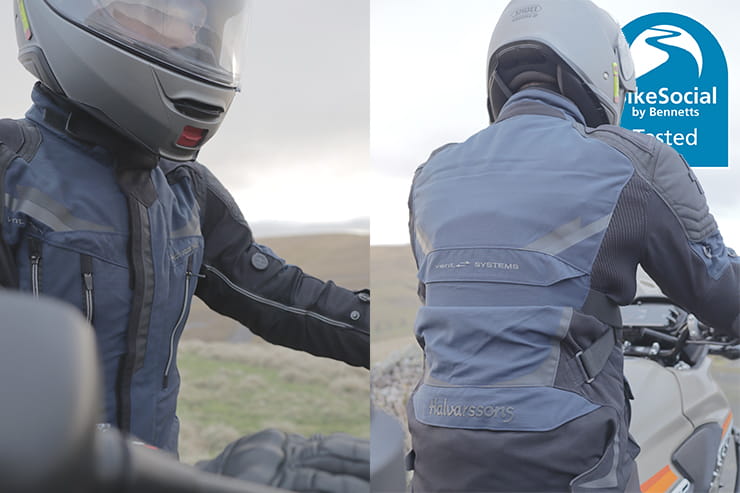
Halvarssons Mora Waterproof Textile Jacket review: Verdict
There is so much to like about the Halvarssons Mora and in many ways it’s an extremely well thought-out and implemented jacket. The adjustability, comfort and quality is outstanding, feeling significantly nicer to the touch than many of its biggest and more well-known rivals.
But it isn’t without it’s flaws. The waterproofing will prove to be a problem for some, and while opting for a jacket with removable liner will always come with some compromise, I was disappointed to see the DWR coating have so little effect in the wet.
All things considered this is an extremely versatile jacket that’s truly capable in almost all conditions and built to last for many thousands of miles. I cannot fault the quality of the Halvarssons finish, the attentiveness to small details and the breadth of features packed into this jacket. Seriously worth consideration if you’re on the more adventurous side of the biking world and need the breathability of a non-laminated jacket.
Three months later: Halvarssons Mulung trousers
The trousers were delayed in delivery, so Ben has added his thoughts on them now he’s been able to put plenty of miles on…
Much like the paired jacket – the Mora – the Halvarssons Mulung trousers are beautifully-finished fully-featured textile trousers with well-chosen premium materials and smart design throughout. Like the jacket there’s loads of clever adjustability with velcro pull-straps on the waist at each hip, and a clever double fly clasp centrally which allows for 2 different waist tensions. They also come supplied with a fairly simple but well-made set of braces and a full-length attachment zip to match the jacket. Fully zipped up there is only a very small gap at the centre, leaving you feeling very well cocooned. At the ankles there’s wider zipped openings with plenty of room for even the biggest adventure boots, all without the flared flapping feeling you get with some setups. In fact I’d say that these are some of the easiest trousers to get big boots under thanks to the liner having plenty of give and the outer shells soft stretchy material.
Like the jacket they opt for a fully-removable waterproof and thermal layer for unrestricted breathability, albeit with only one set of vents on the outer shell to assist with airflow. Although these vents are relatively small they do work well, with plenty of air; even with the liner in their effect is notable.
Despite being extremely thin the liner adds a good amount of warmth without feeling stuffy; in fact it’s proven so effective at regulating temperature I’m yet to remove it (apart from when testing airflow), despite some fairly warm days riding. The waterproof element of the liner works really well too and I’m yet to see any damp get through although I’m yet to put it to the test in truly torrential conditions.
Unfortunately, much like the jacket the liner stops a little short of the end of the limbs, however even relatively short boots would be tall enough for this not to be an issue. I was surprised to find the DWR water resistant coating seemed to be more effective on the trousers than the paired Mora jacket. In light rain there was noticeable beading and the outer material seemed to remain dry.
Much like the Mora there’s a good amount for safety baked in with Hi-Art abrasion throughout, and the armour supplied at the knees and hips. Like the jacket these feel quite firm and the hip armor in particular is quite bulky but reasonably comfortable even during all-day riding. The trousers meet class AA under EN17092, which seems to be about standard for higher-end textile touring kit currently.
Sizing was a little on the large side. I’m usually a 32 short and the supplied were perfect in length but a little large on the waist. That being said there was enough adjustment to get them comfortable. The use of accordion panels at the knees works really well, so much so it’s one of the first pairs of textiles where the length feels perfect in both the stood and sat position, without one or other being compromised.
All in all they are an extremely comfortable textile trouser with loads of adjustment and adaptability ready for just about any adventure. A serious contender with a lovely finish and feel; very little if anything I could fault.






